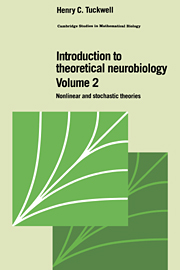10 - The analysis of stochastic neuronal activity
Published online by Cambridge University Press: 27 January 2010
Summary
Introduction
Given a record of the spiking activity of a neuron, the question arises as to what information can be obtained from it. There are many aspects to this question. A primary distinction must be made, of course, between spontaneous and driven activity.
It is a fact that the majority of CNS cells sampled thus far exhibit spontaneous activity. For example, in the cat cochlear nucleus, Pfeiffer and Kiang (1965) found that 80% of the 269 cells studied spontaneously emitted spikes. It is tacitly assumed in most studies that the spontaneous activity is not significantly affected by small doses of anaesthetic. This has been demonstrated for cells of Clarke's column (Pyatigorskii 1966).
The spontaneous, or background, activity is an important object to study for several reasons. First, it is a property of the cell and is of interest in itself. Furthermore, in conjunction with physiologically realistic mathematical models of nerve cells, it may be possible to infer actual nerve-cell properties from the spontaneous activity. Attempts of this kind have been made by Bishop et al. (1964), Braitenberg et al. (1965), Smith and Smith (1965), Correia and Landolt (1977), Tuckwell and Richter (1978), and Tuckwell (1979a). Statistical estimation procedures for parameters in some neuronal random processes have been outlined by Lansky (1983) and will be elaborated upon in Section 10.11.
Information
- Type
- Chapter
- Information
- Introduction to Theoretical Neurobiology , pp. 191 - 246Publisher: Cambridge University PressPrint publication year: 1988
Accessibility standard: Unknown
Why this information is here
This section outlines the accessibility features of this content - including support for screen readers, full keyboard navigation and high-contrast display options. This may not be relevant for you.Accessibility Information
- 3
- Cited by
